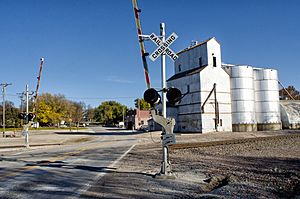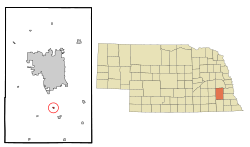Roca, Nebraska facts for kids
Quick facts for kids
Roca, Nebraska
|
|
|---|---|
|
Village
|
|

Roca, Nebraska tracks and silo.
|
|

Location of Roca, Nebraska
|
|
| Country | United States |
| State | Nebraska |
| County | Lancaster |
| Area | |
| • Total | 0.14 sq mi (0.36 km2) |
| • Land | 0.14 sq mi (0.36 km2) |
| • Water | 0.00 sq mi (0.00 km2) |
| Elevation | 1,247 ft (380 m) |
| Population
(2020)
|
|
| • Total | 201 |
| • Density | 1,446.04/sq mi (559.23/km2) |
| Time zone | UTC-6 (Central (CST)) |
| • Summer (DST) | UTC-5 (CDT) |
| ZIP code |
68430
|
| Area code(s) | 402 |
| FIPS code | 31-41830 |
| GNIS feature ID | 2399098 |
Roca is a small village located in Lancaster County, Nebraska. It is part of the larger Lincoln, Nebraska area. In 2020, about 201 people lived there.
| Top - 0-9 A B C D E F G H I J K L M N O P Q R S T U V W X Y Z |
Discovering Roca's Location
Roca is a very small place, covering only about 0.14 square miles (0.36 square kilometers) of land. It doesn't have any large bodies of water within its borders.
Who Lives in Roca?
| Historical population | |||
|---|---|---|---|
| Census | Pop. | %± | |
| 1880 | 115 | — | |
| 1890 | 191 | 66.1% | |
| 1900 | 177 | −7.3% | |
| 1910 | 129 | −27.1% | |
| 1920 | 133 | 3.1% | |
| 1930 | 107 | −19.5% | |
| 1940 | 127 | 18.7% | |
| 1950 | 105 | −17.3% | |
| 1960 | 123 | 17.1% | |
| 1970 | 118 | −4.1% | |
| 1980 | 130 | 10.2% | |
| 1990 | 84 | −35.4% | |
| 2000 | 220 | 161.9% | |
| 2010 | 220 | 0.0% | |
| 2020 | 201 | −8.6% | |
| U.S. Decennial Census | |||
Roca's Population in 2010
In 2010, there were 220 people living in Roca, making up 81 households. Most of these (61) were families. The village had about 1,571 people per square mile.
Many households (43.2%) had children under 18 living with them. Most households (65.4%) were married couples. About 18.5% of households were single individuals. The average household had 2.72 people.
The average age in Roca was 34.5 years. Nearly 30% of residents were under 18. About 5.5% were 65 years or older. There were slightly more males (53.6%) than females (46.4%) in the village.
Roca's Past: A Stone Story
Roca's population reached 190 people in 1890, which was its highest number before recent times. The local post office opened on September 22, 1894. When the town was planned in 1876, people wanted a name that showed what was important there: stone quarrying. That's why they chose "Roca," which means "stone" in Spanish.
Early Settlers and Challenges
In 1857, the Prey family moved from Wisconsin to settle near a planned town called "Olathe." People had high hopes for this area, which was then called "Clay County." However, not many people came to live so far out on the prairie. While there weren't big fights with Native Americans, there were some scary moments that made settlers leave.
In 1861, Delos and Frances Mills built a small stone house near Salt Creek. They used limestone from a nearby rock ledge. This was the start of the stone quarries that became a major business.
Changes in County Lines
In 1863, "Clay County" was split up, and Roca's land became part of Lancaster County. Only a few original settlers, like the Prey family, stayed. In 1864, Elmore Keys bought the Prey family's log cabin and moved it.
Why Roca Wasn't the Capital
In 1867, a group looked for a place for Nebraska's capital city. The Mills farm, with its stone quarries, was suggested because it had good building materials. But the town of Lancaster (which later became Lincoln) was chosen instead. When the statehouse was built in 1868, the stone from Roca's quarry was not considered good enough.
The Railroad and a New Name
In 1869, the quarry workers built a school. When the Atchison & Nebraska Railroad built its line through the area in 1871, a station was needed. Haskel Warner, who had worked in New Mexico, suggested the name "Roca" because it meant "rock" in Spanish.
Elmore Keys and John Meyer gave land for the town, and it was officially planned. The large stone house Keys built on a hill is still a beautiful home today. The town quickly grew and became an official village in 1876.
Growing Businesses and Schools
In 1875, a new quarry called the Blue Stone quarry opened. Stone from these quarries was used to build many buildings in Lincoln and other places. Quarrying was active in the area for over 100 years.
By 1879, more students needed a schoolhouse. Soon, an even larger wooden building was built. By 1882, there were 280 students. Businesses included a motel, a mill, a hardware store, a lumberyard, and other shops. Main Street faced Salt Creek, with the train depot across the street.
Fires and Changes
Fires destroyed several businesses in 1891, the mill around 1900, and the hotel in 1910. By then, the quarries were not producing as much stone. Businesses that were destroyed often did not rebuild. In 1933, a large brick schoolhouse was built. It served the community until 1964, when it joined the Norris School District.
Churches and Cemeteries
A Methodist church, built by quarry workers in 1876, was enlarged in 1925. Sadly, it burned down in 1969. A new church was built, which still has a small but active group of people. A small Lutheran church near the school was active until 1916.
The first cemetery was north of town. In 1876, the current cemetery was started on land given by the Keys family. The "old stone store" was built from quarry rock in 1879 as a blacksmith shop. Over the years, it has been a community hall and a grocery store with an apartment upstairs.
See also
 In Spanish: Roca (Nebraska) para niños
In Spanish: Roca (Nebraska) para niños


